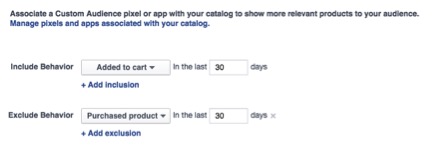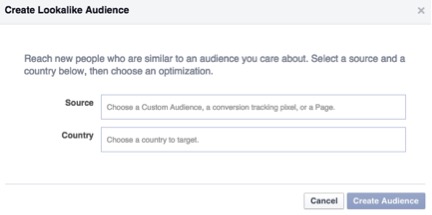Facebook can be a great place for ecommerce companies to advertise products and build awareness for their brands. The amount of users on Facebook is massive, with the most recent earnings report indicating that 1.49 billion monthly active users and 1.31 billion mobile monthly active users are on the site. That’s a lot of users that likely includes your current customers and plenty of potential new customers.
While many ecommerce companies use Facebook’s pages to reach out to fans with regular announcements and updates, they may be looking to utilize Facebook’s paid advertising options. The goals include increasing the reach of their brand and dialing in their targeting to audiences that are most likely to buy and become future customers.
So if you’re an ecommerce company looking to charge up your marketing efforts with paid ads on Facebook you’re probably wondering what’s a good general strategy to get started.
It’s really a two-step strategy.
First, you’ll likely want to utilize Dynamic Product Ads to remarket to people who’ve already expressed an interest in your brand and products by viewing or purchasing products from your site. This is an easy tactic to recapture the intent of those who’ve already expressed some intent in the past.
Second, you’ll want to use a strategy that can expand your customer base and increase sales. You do this by introducing your brand and products to people who aren’t aware of them, but are likely to buy based on similarities to past customers. Here you’ll use lookalike audiences.
Let’s look into these two strategies in more detail.
Dynamic Product Ads
Dynamic Product Ads allow a company to show ads promoting products to people who have shown an interest in that product. This might be through visiting a product page, adding a product to a shopping cart, or buying the product.
The engine that drives this matching behavior is a fun bit of code called the custom audience pixel. While we’re using it here to run our product ads, it can be used to do a whole lot more. While going into detail on the pixel isn’t the focus of this blog post, you can read up on it more here.
From a strategy perspective, the real fun starts when we begin to break this audience into the three standard segments for Dynamic Product Ads:
- Viewed content
- Added to cart
- Purchased product
“Added to cart” and “Purchased product” are self-explanatory, but “Viewed content” means anyone who visited a specific product page.
Pending you have all your pixel codes placed in the right areas you can now remarket and re-engage with these people as they use Facebook.

This allows you to get people who’ve already shown an interest in a product (view content) or really shown an interest (added to cart) to come back and potentially purchase that product by reintroducing it to top of mind. You can exclude those who have already purchased to focus on getting at those most likely to purchase in the short term, though there can be strategic reasons for targeting purchasers.
It also opens up all sorts of possibilities for ads to be customized based on the action they took on the site. People who just viewed a product will get an ad showing them that product, but they also could be shown related products that might also interest them.
Someone who added something to cart could be shown only the product they added to cart with a free shipping or 10% off code to entice them to purchase since they had shown more intent to purchase in the past.
Dynamic Product Ads allows ecommerce companies to step into Facebook paid advertising in a way that is strategic, but limits exposure to people that have already shown some level of interest in various products. It then allows a company to recapture that intent with custom targeted messaging as they move within the Facebook ecosystem.
So how does that same ecommerce company use its dynamic product ad audiences to build awareness, find new customers, and ultimately drive new sales?
Lookalike Audiences
Facebook offers many different ways to target people, but one in particular provides a great way to use our remarketing audience above to “find” people who haven’t visited a product page or are aware of the brand (at least not recently) using the magic of Facebook’s algorithms and wealth of targeting data.
Lookalike audiences are exactly what they sound like – an audience that is created to resemble (or look like) another audience based on demographics and interests. In our case, we’re looking for an audience that resembles those that meet the criteria already mentioned: viewed content, added to cart, or purchased. Using the demographic and other information provided by users, Facebook can attempt to match our ads to people who haven’t been to our site, but “look” like those who have.
So how do we go about using a lookalike audience to reach new people?
It’s pretty simple. If your pixels above are accurately grabbing those who viewed content, added to cart, and purchased then you just have to create a custom lookalike audience using that conversion pixel and let Facebook work its magic.

The real strategy with these audiences is in the creation of the ad itself. Since these are people who are new to your brand, you’ll need to convince them to click the ad and check out your products.
It could come in the form of a single image ad that highlights your brand and story or it could be a carousel ad that highlights categories of products. The key thing to remember is that these people don’t know you or your brand. The ball is squarely in your court to entice them to click once Facebook is able to find them.
To take the strategy a bit further, we could create three different lookalike audiences based on each of the three sub pixels from above (viewed content, added to cart, purchased product).
Then you could have tailored messages for each and be able to measure which segment and which ad performs the best.
Conclusion
If you’re looking for an ecommerce play, Dynamic Product Ads and lookalike audiences give you an end-to-end strategy for re-engaging with existing customers and reaching out to potential new customers. It’s a great strategy for ecommerce companies that are slowly expanding marketing into Facebook and vetting performance without resorting to more risky targeting.



